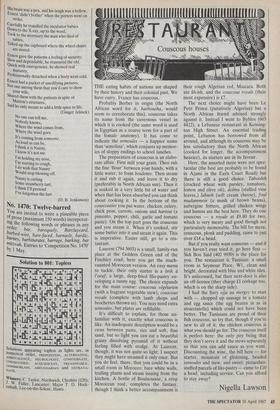110011111Ull.11,11JIMIVIUMW
Couscous houses
THE eating habits of nations are shaped by their history and their colonial past. We have curry, France has couscous.
Probably Berber in origin (the North African word for it, barbousha, would seem to corroborate this), couscous takes its name from the cavernous vessel in which it is cooked (the same word is used in Egyptian as a coarse term for a part of the female anatomy). It has come to indicate the semoules — a happier name than 'semolina', which-conjures up memor- ies of sloppy endings to school lunches.
The preparation of couscous is an elabo- rate affair. First mill your grain. Then rub the fine 'flour' between your hands, with a little water, to form boulettes. Then steam it and rub it again, and leave it to dry (preferably in North African sun). Then it is soaked in a very little bit of water and when that has been absorbed you can think about cooking it. In the bottom of the couscousier you put water, chicken, celery, chick peas, carrots, onions and harissa (a pimento, pepper, chili, garlic and tomato paste). On the top part goes the couscous and you steam it. When it's cooked, stir some butter into it and steam it again. This is imperative. Easier still, go to a res- taurant.
Laurent (794 3603) is a small, family-run place at the Golders Green end of the Finchley road; here you get the much- vaunted Moroccan version. An easy menu to tackle, their only starter is a brik a l'oeuf, a large, deep-fried filo-pastry en- veloping a runny egg. The choice expands for the main course: couscous vdgdtarien (with a fragrant vegetable stew), couscous royale (complete with lamb chops and brochettes thrown in). You may need extra semoules, but plates are refillable.
It's difficult to explain, for those un- familiar with it, exactly what couscous is like. An inadequate description would be a cross between pasta, rice and soft, fine sand, but so light you can eat a beautiful grainy dissolving pyramid of it without feeling filled with stodge. At Laurent, though, it was not quite so light: I suspect they might have steamed it only once. But you do feel, there, that you could be in a small room in Morocco: bare white walls, trailing plants and steam issuing from the kitchen. A bottle of Boulaouane, a crisp Moroccan rosé, completes the fantasy, though I think a better accompaniment is their rough Algerian red, Mascara. Both are £6-ish, and the couscous royale (their most expensive) is £7.
The next choice might have been Le Petit Prince (putatively Algerian) but a North African friend advised strongly against it. Instead I went to Byblos (603 4422), a Lebanese restaurant in Kensing- ton High Street. An essential trading point, Lebanon has borrowed from all around, and although its couscous may be less satisfactory than the North African (cooked for longer, the accompaniment heavier), its starters are in its favour.
Here, the assorted meze were not spec- tacular (the best are probably to be found in Ajami in the Earls Court Road) but there is still a good choice. Tabooleh (cracked wheat with parsley, tomatoes, lemon and olive oil), dolma (stuffed vine leaves,) labneh (soft cream cheese), foul mudammess (a mush of brown beans), aubergine fritters, grilled chicken wings and humus are the best here. They do one couscous — a royale at £9.80 for two, which is very meaty and good though not particularly memorable. The bill for meze, couscous, plonk and pudding, came to just over £14 a head.
But if you really want couscous — and if you haven't ever tried it, go here first Sidi Bou Said (402 9930) is the place for you. The restaurant is Tunisian: a small room in Seymour Place, W1, clean and bright, decorated with blue and white tiles. It's unlicensed, but their next-door is also an off-licence (they charge £1 corkage too, which is on the sharp side).
I had the fiery ojja au mergez to start with — chopped up sausage in a tomato and egg sauce (the egg beaten in as in stracciatella) which could not have been better. The Tunisians are proud of their fish couscous, so try that, though if you're new to all of it, the chicken couscous is what you should go for. The couscous itself is perfect here: the only pity being that they don't serve it and the stews separately so that you can add sauce as you want. Discounting the wine, the bill here — for starter, mountain of glistening, beaded semoules and stew, and sweet, pistacchio- stuffed parcels of filo-pastry — came to £10 a head, including service. Can you afford to stay away?
Nigella Lawson


















































 Previous page
Previous page